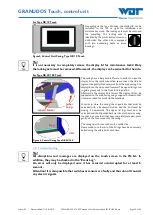
GRANUDOS Touch, control unit
Index: 02
Date modified: 11/06/2019
OI No.: BA SW 010-02 Granudos Touch-Steuereinheit EN SCHW 8.docx
Page 32 of 43
8
Decommissioning – Storage – Disposal
8.1
General
In the event of decommissioning or risk of frost, the devices must be emptied completely and protected
against frost!
8.2
Decommissioning
If the device is decommissioned for an extended period of time (more than approx. 14 days), the following
tasks must be conducted.
Depending on the device version, different measures are required for decommissioning. The following works
relate exclusively to the pH-measurement techniques.
For required work on the dosing devices, please consult the corresponding device manuals.
The diaphragm of a glass electrode must never dry out. The longest service life for electrodes when not
in use can be reached if the glass shaft is stored in the electrolyte. To do this, the protective cover is filled
to about half-way with electrolyte and pushed onto the glass shaft of the electrode.
The glass electrodes are frost-resistant to approx. -15°C; if the temperature falls below this value, the
electrodes must be stored in a frost-safe environment.
If condensation moisture can be expected at the installation site, the device must be supplied with
continuous voltage in order to protect the electronics. Alternatively, the device may be dismounted and
stored in a dry location.
If frost is expected at the installation site, all water-conveying parts, such as measuring water pipes and
measuring cell, must be emptied completely.
8.3
Disposal of used parts and operating materials
Clean dismounted, contaminated parts thoroughly first and dispose of them, or have them recycled, in
accordance with the regulations applicable at the operating location. Observe the relevant instructions on the
packaging for the operating materials. In case of doubt, information may be obtained from the authorities
responsible for disposal at your location.
If this is not possible, dispose of the parts/substances as hazardous waste.


























